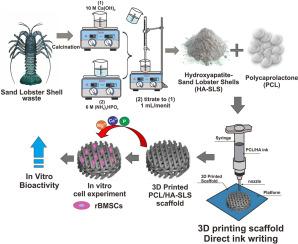以沙龙虾壳(Panulirus homarus)废料为原料制备三维高分子生物陶瓷支架,作为提高体外生物活性的可持续资源
Q1 Computer Science
引用次数: 0
摘要
由于感染和疾病传播的风险,同种异体骨移植和自体骨移植治疗骨折的方法仍然具有挑战性。羟基磷灰石(HA)等磷酸钙生物陶瓷骨移植;(Ca10(PO4)6(OH)2))广泛应用于临床,因为HA是构成骨的最大化合物。然而,商用透明质酸具有脆性力学性能,并且在天然骨中缺乏无机矿物质。除此之外,传统的骨移植制备方法,如孔隙素浸出、冷冻干燥和发泡,会产生不均匀的支架设计。在这项研究中,我们成功地以聚合物聚己内酯(PCL)和生物陶瓷羟基磷灰石为材料,制备了3D打印支架复合材料直接墨水书写(DIW)。一种能产生精确孔隙形状和支架设计的聚脲(Panulirus homarus)废物(HA-SLS)。利用沙龙虾壳新型生物废弃物源,其天然镁离子含量为6.93%,以β-磷酸三钙镁(β-TCMP)的形式存在,可提高其生物活性。3D PCL/HA-SLS分别为0%、10%、30%和50%,然后在SBF溶液中进行生物矿化和细胞对兔骨髓干细胞(rBMSCs)的反应,以评估HA-SLS对支架生物活性的影响。结果表明,将HA-SLS掺入PCL可释放生物活性离子Ca、P和Mg,对兔骨髓干细胞(rBMSCs)具有良好的粘附、增殖和成骨分化作用。较高浓度的HA-SLS可以刺激rBMSCs的成骨分化,与纯PCL相比,其表现为碱性磷酸盐活性、茜素红和骨相关基因表达增加,从而促进骨再生。聚合物-生物陶瓷复合材料还可以通过阻止脆性断裂,提高最终压缩状态下的韧性和抗断裂能力来改善其力学性能,因此该策略可以在骨组织工程中获得良好的力学性能和生物活性响应。本文章由计算机程序翻译,如有差异,请以英文原文为准。

Direct ink writing of 3D scaffold polymeric-bioceramic from sand lobster shells (Panulirus homarus) waste as a sustainable resouce for enhancing in vitro bioactivity
Allografts and autografts methods for bone fracture healing remain challenging due to infection and disease transmission risk. Bone grafts from calcium-phosphate bioceramics such as hydroxyapatite (HA; (Ca10(PO4)6(OH)2)) are widely applied in clinical use because HA is the largest compound that makes up bone. However, commercial HA has brittle mechanical properties and lacks inorganic minerals in native bone. Apart from that, conventional methods for bone graft preparation, such as porogen leaching, freeze drying, and foaming, produce inhomogeneous scaffold designs. In this study, we successfully fabricated the 3D printing scaffold composite direct ink writing (DIW) from polymer polycaprolactone (PCL) and bioceramic hydroxyapatite from sand lobster shell (SLS; Panulirus homarus) waste (HA-SLS) which can produce precise pore shapes and scaffold designs. Using new biogenic waste sources from sand lobster shells has a natural Mg ion content of 6.93 % in the form of β-tricalcium-magnesium phosphate (β-TCMP), which can increase its bioactivity. 3D PCL/HA-SLS was varied at 0 %, 10 %, 30 %, and 50 %, and then biomineralization in SBF solution and cell responses to rabbit bone marrow stem cells (rBMSCs) were conducted to evaluate the effect of HA-SLS on scaffold bioactivity. The results show that incorporation of HA-SLS into the PCL can release the bioactive ions Ca, P, and Mg, which provide good biological responses to the rabbit bone marrow stem cells (rBMSCs) for cell adhesion, proliferation, and osteogenesis differentiation. A higher concentration of HA-SLS can stimulate osteogenesis differentiation of rBMSCs, which is marked by increased alkaline phosphate activity, alizarin red, and bone-related gene expression compared to pure PCL, which can promote bone regeneration. Polymer-bioceramic composites can also improve their mechanical properties by hindering brittle fracture and increasing the toughness and resistance to fracture in the final compression state, so this strategy can obtain good mechanical properties and bioactivity responses in bone tissue engineering.
求助全文
通过发布文献求助,成功后即可免费获取论文全文。
去求助
来源期刊

Bioprinting
Computer Science-Computer Science Applications
CiteScore
11.50
自引率
0.00%
发文量
72
审稿时长
68 days
期刊介绍:
Bioprinting is a broad-spectrum, multidisciplinary journal that covers all aspects of 3D fabrication technology involving biological tissues, organs and cells for medical and biotechnology applications. Topics covered include nanomaterials, biomaterials, scaffolds, 3D printing technology, imaging and CAD/CAM software and hardware, post-printing bioreactor maturation, cell and biological factor patterning, biofabrication, tissue engineering and other applications of 3D bioprinting technology. Bioprinting publishes research reports describing novel results with high clinical significance in all areas of 3D bioprinting research. Bioprinting issues contain a wide variety of review and analysis articles covering topics relevant to 3D bioprinting ranging from basic biological, material and technical advances to pre-clinical and clinical applications of 3D bioprinting.
 求助内容:
求助内容: 应助结果提醒方式:
应助结果提醒方式:


